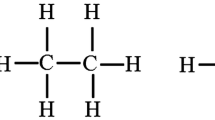Abstract
A molecular-level kinetics model has been developed for the pyrolysis of heavy residual oil. Resid structure was modeled in terms of three attribute groups: cores, inter-core linkages, and side chains. The concentrations of attributes were constrained by probability density functions (PDFs) that were optimized by minimizing the difference between the properties of the computational representation—which were obtained by juxtaposing the attributes—to measured properties, which were obtained by analytical chemistry measurements. Computational tools were used to build a reaction network that was constructed based upon model compounds and their associated kinetics. For cases with an intractable number of species, equations were written in terms of the three attribute groups and the molecular composition was retained implicitly through the juxtaposition. These modeling methods were applied to the Shengli and Daqing resids. The composition of the simulated molecular feedstock fit well with analytical chemistry measurements. After simulated pyrolysis, both resids showed representative increases in the weight fractions of lighter hydrocarbons. Relevant end-use properties were predicted for the product mixtures.
Similar content being viewed by others
References
Swain EJ. Sulfur, coke, and crude quality-conclusion: US crude slate continues to get heavier, higher in sulfur. Oil Gas J, 1995, 93: 37–42
Rodgers RP, McKenna AM. Petroleum analysis. Anal Chem, 2011, 83: 4665–4687
Clean Air Act § 101–131 U.S S.CC. § 74 7401–7431, 199
Flory PJ. Principles of Polymer Chemistry. New York: Cornell University Press, 1953
Grant DM, Pugmire RJ, Fletcher TH, Kerstein AR. Chemical model of coal devolatilization using percolation lattice statistics. Energ Fuel, 1989, 3: 175–186
Fisher ME, Essam JW. Some cluster size and percolation problems. J Math Phys, 1961, 2: 609
Hou Z. Software tools for molecule-based kinetic modeling for complex systems, Rutgers, 2011.
Shixiong L. Petroleum refining engineering (3rd Edition), 2005
Bennett CA. User-controlled kinetic network generation with ingen, Rutgers University, 2009, Vol. PhD
Wei W, Bennett CA, Tanaka R, Hou G, Klein MTJ, Klein MT. Computer aided kinetic modeling with KMT and KME. Fuel Process Technol, 2008, 89: 350–363
Klein MT, Virk PS. Modeling of lignin thermolysis. Energ Fuel, 2008, 22: 2175–2182
Nigam A, Klein MT. A mechanism-oriented lumping strategy for heavy hydrocarbon pyrolysis: Imposition of quantitative structure-reactivity relationships for pure components. Ind Eng Chem Res, 1993, 32: 1297–1303
Savage PE, Klein MT. Asphaltene reaction pathways. 2. Pyrolysis of n-pentadecylbenzene. Chem Eng Sci, 1989, 44: 985–991
Savage PE, Klein MT. Kinetics of coupled reactions: Lumping pentadecylbenzene pyrolysis into three parallel chains. Industrial & Engineering Chemistry Research, 1989, 44: 393–404
Savage PE, Klein MT. Asphaltene reaction pathways. 4. Pyrolysis of tridecylcyclohexane and 2-ethyltetralin. Ind Eng Chem Res, 1988, 27: 1348–1356
Voge HH, Good GM. Thermal cracking of higher paraffins. J Am Chem Soc, 1949, 71: 593–597
Author information
Authors and Affiliations
Corresponding author
Rights and permissions
About this article
Cite this article
Horton, S.R., Hou, Z., Moreno, B.M. et al. Molecule-based modeling of heavy oil. Sci. China Chem. 56, 840–847 (2013). https://doi.org/10.1007/s11426-013-4895-8
Received:
Accepted:
Published:
Issue Date:
DOI: https://doi.org/10.1007/s11426-013-4895-8




